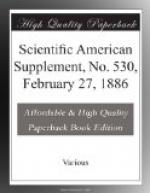Silica, with traces of tin 40.000
Magnesia 26.600
Peroxide of iron 27.700
Metallic iron 3.500
Metallic nickel 0.800
Alumina 0.400
Chlorine 0.049
Phosphoric acid not weighed —
______
99.049”
Messrs. Dewar and Ansdell analyzed the gases in the meteorite, of which it contained three times its volume; the gases were in the following proportions to each other:
Carbonic acid 61.29
Carbonic oxide 7.52
Hydrogen 30.96
Nitrogen 0.23
______
100.00
* * * * *
TELESCOPIC SEARCH FOR THE TRANS-NEPTUNIAN PLANET.
[Footnote: By David P. Todd, M.A., from the Proceedings of the American Academy of Arts and Science.]
In the twentieth volume of the American Journal of Science, at page 225, I gave a preliminary account of my search, theoretic and practical, for the trans-Neptunian planet. I say the trans-Neptunian planet, because I regard the evidence of its existence as well-founded, and further because, since the time when I was engaged upon this search, nothing has in the least weakened my entire conviction as to its existence in about that part of the sky assigned; while, as is well known, the independent researches in cometary perturbations by Prof. Forbes conducted him to a result identical with my own—a coincidence not to be lightly set aside as pure accident.
That five years have elapsed since this coincidence was remarked, and the planet is still unfound, is not sufficient assurance to me that its existence is merely fanciful. In so far as I am informed, this spot of the sky has received very little scrutiny with telescopes competent to such a search; and most observers finding nothing would, I suspect, prefer not to announce their ineffective search.




